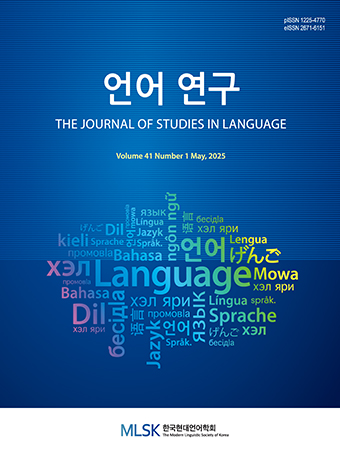Research Article
Abstract
References
Information
This study acoustically analyzes the production of English fricatives (/f/, /v/, /θ/, /ð/, /s/, /z/, /ʃ/, /ʒ/) by ten native speakers from the United States and 40 Chinese EFL learners (of various English proficiency levels). Six acoustic parameters proved to be capable of distinguishing places of articulation, voicing and vowel contexts from previous studies are considered: spectral mean (M1), variance (M2), skewness (M3), kurtosis (M4), relative amplitude and normalized duration. The statistical results reveal that: Firstly, the six acoustic parameters work differently in distinguishing places of articulation, voicing, and vowel contexts between native speakers and advanced learners and beginners. The effect of vowel context becomes weaker with the improvement of L2 proficiency. Secondly, Chinese EFL learners demonstrate significant differences in acoustic features with native speakers in English fricative production, which indicates that Chinese EFL learners face challenges in producing native-like English fricatives. Besides, advanced learners are found to demonstrate a performance more similar to native speakers (less significant differences in acoustic characteristics with native speakers) than beginners. Lastly, segmental substitutions errors of /v/-/w/ and /ʒ/-/r/ are observed in Chinese EFL learners.
- Bohn, O. S. and J. E. Flege. 1990. Interlingual Identification and The Role of Foreign Language Experience in L2 Vowel Perception. Applied Psycholinguistics 11.3, 303-328. 10.1017/S0142716400008912
- Bohn, O. S. and J. E. Flege. 1992. The Production of New and Similar Vowels by Adult German Learners of English. Studies in Second Language Acquisition 14.2, 131-158. 10.1017/S0272263100010792
- Chen, X. 2012. A Linear Regression Analysis on TEM4. Journal of Civil Aviation Flight University of China 6, 020.
- Chen, Y. and R. Bi. 2008. English Majors’ Pronunciation and Intonation in Read Speech: A Longitudinal Study. Journal of PLA University of Foreign Languages 31.4, 43-49.
- Cheng, C. M. and A. P. He. 2008. An Analysis of Oral Segmental Errors of Advanced English Learners. Journal of PLA University of Foreign Languages 31.1, 38-42.
- Christian, D. 2013. https://www.acsu.buffalo.edu/~cdicanio/scripts/Time_averaging_for_fricatives_2.0.praat.
- Flege, J. E. 1995. Second Language Speech Learning: Theory, Findings, and Problems. Speech perception and linguistic experience: Issues in cross-language research 92, 233-277.
- Gao, H. P. 2002. How to Pronounce Fricative Consonants and Affricates Consonants Well in English. Journal of LuLang Education Institute 19.4, 34-35.
- Hughes, G. W. and M. Halle. 1956. Spectral Properties of Fricative Consonants. The Journal of the Acoustical Society of America 28.2, 303-310. 10.1121/1.1908271
- Jin, Y. and J. Fan. 2011. Test for English Majors (TEM) in China. Language Testing 28.4, 589-596. 10.1177/0265532211414852
- Jongman, A., R. Wayland, and S. Wong. 2000. Acoustic Characteristics of English Fricatives. The Journal of the Acoustical Society of America 108.3, 1252-1263. 10.1121/1.1288413 11008825
- Ladefoged, P. and K. Johnson. 2014. A Course in Phonetics. Nelson Education.
- Li, F. (2008). The Phonetic Development of Voiceless Sibilant Fricatives in English, Japanese and Mandarin Chinese (Doctoral dissertation, The Ohio State University).
- Maniwa, K., A. Jongman, and T. Wade. 2008. Perception of Clear Fricatives by Normal-hearing and Simulated Hearing- impaired Listeners. The Journal of the Acoustical Society of America 123.2, 1114-1125. 10.1121/1.2821966 18247912
- Maniwa, K., A. Jongman, and T. Wade. 2009. Acoustic Characteristics of Clearly Spoken English Fricatives. The Journal of the Acoustical Society of America 125.6, 3962-3973. 10.1121/1.2990715 19507978
- Nittrouer, S. 1995. Children Learn Separate Aspects of Speech Production at Different Rates: Evidence from Spectral Moments. The Journal of the Acoustical Society of America 97.1, 520-530. 10.1121/1.412278 7860830
- Nittrouer, S., M. Studdert-Kennedy, and R. S. McGowan. 1989. The Emergence of Phonetic Segments: Evidence from the Spectral Structure of Fricative-vowel Syllables Spoken by Children and Adults. Journal of Speech, Language, and Hearing Research 32.1, 120-132. 10.1044/jshr.3201.120
- Shadle, C. H. 2012. Acoustics and Aerodynamics of Fricatives. The Oxford Handbook of Laboratory Phonology 511-526.
- Shadle, C. H. and S. J. Mair. 1996, October. Quantifying Spectral Characteristics of Fricatives. In Proceeding of Fourth International Conference on Spoken Language Processing. ICSLP’96 (Vol. 3, pp. 1521-1524). IEEE.
- Sui, Z. H. and C. B. Li. 1998. Analysis of Errors in Teaching English Pronunciation. Journal of ZaoZhuang University 2, 78-80.
- Tian, X. H. 2015. A Study on the Reliability and Validity of TEM 4. Teaching of Forestry Region 1, 42-43.
- Wagner, A., M. Ernestus, and A. Cutler. 2006. Formant Transitions in Fricative Identification: The Role of Native Fricative Inventory. The Journal of the Acoustical Society of America 120.4, 2267-2277. 10.1121/1.2335422 17069322
- Wilde, L. F. 1995. Analysis and Synthesis of Fricative Consonants. Doctoral dissertation, Massachusetts Institute of Technology.
- Wu, J. X. 2008. Comparison between Chinese and English Fricatives. Journal of Mudanjiang Normal Universit 5, 69-70.
- Zhang, Y. and J. Xiao. 2011. A Study of Chinese EFL Learners’ Acquisition of English Fricatives. In 16th Conference of the Pan-Pacific Association of Applied Linguistics, Hong Kong. Retrieved from http://paaljapan.org/conference2011/ProcNewest2011/pdf/oral/2B-3. pdf.
- Zhang, Y. and J. Xiao. 2014. An Analysis of Chinese Students’ Perception and Production of Paired English Fricatives: From an ELF Perspective. Journal of Pan-Pacific Association of Applied Linguistics 18.1, 171-192.
- Publisher :The Modern Linguistic Society of Korea
- Publisher(Ko) :한국현대언어학회
- Journal Title :The Journal of Studies in Language
- Journal Title(Ko) :언어연구
- Volume : 35
- No :4
- Pages :599-626
- DOI :https://doi.org/10.18627/jslg.35.4.202002.599




 The Journal of Studies in Language
The Journal of Studies in Language






